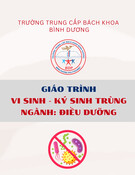
2
Nghiên cứu Dược & Thông tin thuốc 2023, Tập 14, Số 4, trang 2-9
BÀI NGHIÊN CỨU
selection vancomycin population pharmacokinetic
model for individualized dosing precision based on
Bayes approach in adult patients at the hospital
for Tropical Diseases, ho chi Minh city
Nguyen Thi Cuca, Truong Thuy Quynhb, Le Dinh Vana, Nguyen Hoang Anh(1),a,
Tang Quoc Ana, Le Dang Tu Nguyenb, Nguyen Tran Nam Tiena, Ha Mai Phuongb, Do Ngoc Tuanc,
Nguyen Hoang Anha, Huynh Phuong Thaob, Vu Dinh Hoaa,*
aNational DI & ADR Centre, Hanoi University of Pharmacy, 13-15 Le Thanh Tong, Hanoi, Vietnam
bHospital for Tropical Diseases, Ho Chi Minh City, 764 Vo Van Kiet, Ho Chi Minh, Vietnam
cN2TP Technology Solutions joint stock company, 243 Giap Bat, Hanoi, Vietnam
*Corresponding author: Vu Dinh Hoa; e-mail address: hoavd@hup.edu.vn
Doi: 10.59882/1859-364X/125
abstRaCt
The population pharmacokinetic (popPK) model is a crucial element of the model-
informed precision dosing (MIPD) platform to optimize population- and individual-based
dosage regimens. This study aimed to identify a suitable popPK model serving for the MIPD-
based vancomycin therapeutic drug monitoring in adult patients at the Hospital for Tropical
Diseases, Ho Chi Minh City. Retrospective data from 1206 general hospitalized patients with
2179 blood vancomycin concentrations were used to evaluate two vancomycin popPK
models, including those reported by Goti (2018) and Buelga (2005). The validity and
predictive performance of the investigated popPK models were evaluated by a priori
prediction, conventional Bayesian forecasting, and flattened Bayesian forecasting
approaches using relative bias (rbias) and relative root mean squared error (rRMSE) as
indicative metrics. The model published by Goti predicted our patients’ data better than
Buelga’s model in terms of a priori (rBias 18,5% vs. -31,7%), conventional Bayesian
forecasting (rBias 15,5% vs. -30,6%) and flattened Bayesian forecasting (rBias -1,6% vs. -
17,3%). The flattened Bayesian estimation demonstrated superior predictability accuracy
and precision rather than the conventional Bayesian approach, especially with the Goti’s
model (rBias -1,6% vs. 15,5% and rRMSE 45,3% vs. 56,5%). In conclusion, the Goti’s model
integrated in MIPD is more appropriate for precision dosing of vancomycin at the bedside.
Keywords: Priori prediction; Bayesian forecasting; Flattened Bayesian; PopPK; Predictive
performance Vancomycin; The hospital for Tropical Diseases Ho Chi Minh city.

3
Nghiên cứu Dược & Thông tin thuốc 2023, Tập 14, Số 4, trang 2-9
Lựa chọn mô hình dược động học quần thể của
vancomycin ứng dụng trong hiệu chỉnh liều theo
phương pháp Bayes trên bệnh nhân người lớn
tại Bệnh viện Bệnh nhiệt đới TP. hồ chí Minh
Nguyễn Thị Cúca, Trương Thúy Quỳnhb, Lê Đình Văna, Nguyễn Hoàng Anh(1)a, Tăng Quốc Ana,
Lê Đặng Tú Nguyênb, Nguyễn Trần Nam Tiếna, Hà Mai Phươngb, Đỗ Ngọc Tuấnc,
Nguyễn Hoàng Anha, Huỳnh Phương Thảob, Vũ Đình Hòaa,*
aTrung tâm DI & ADR Quốc gia, Trường Đại học Dược Hà Nội, 13-15 Lê Thánh Tông, Hà Nội, Việt Nam
bBệnh viện Bệnh Nhiệt đới Thành phố Hồ Chí Minh, 764 Võ Văn Kiệt, Thành phố Hồ Chí Minh, Việt Nam
cCông ty cổ phần giải pháp công nghệ N2TP, 243 Giáp Bát, Hà Nội, Việt Nam
* Tác giả liên hệ: Vũ đình Hòa; địa chỉ e-mail: hoavd@hup.edu.vn
D oi: 10.59882/1859-364X/125
(Ngày gửi đăng: 10/08/2023 - Ngày duyệt đăng: 20/10/2023)
tóM tẮt
Mô hình dược động học quần thể (popPK) là một trong những cấu phần quan trọng nhất
của ứng dụng cho liều chính xác dựa trên mô hình (MIPD) để từng bước tối ưu hóa chế độ liều
dựa trên tiếp cận quần thể và tiếp cận cá thể. Xác định mô hình popPK vancomycin phù hợp
cho ứng dụng TDM và hiệu chỉnh liều thuốc trên bệnh nhân người lớn tại Bệnh viện Bệnh nhiệt
đới TP Hồ Chí Minh. Dữ liệu hồi cứu từ 1206 bệnh nhân với tổng cộng 2179 mẫu nồng độ
vancomycin trong máu được sử dụng để đánh giá tính phù hợp của hai mô hình popPK
vancomycin, bao gồm mô hình của Goti (2018) và Buelga (2005). Khả năng dự đoán của các
mô hình được đánh giá dựa trên tiếp cận dự đoán từ mô hình popPK tiên nghiệm, dự đoán
Bayes thông thường và dự đoán Bayes phẳng thông qua chỉ số độ lệch tương đối (rBias) và độ
chính xác tương đối (rRMSE). Mô hình của Goti (2018) cho khả năng dự đoán tốt và phù hợp
với quần thể bệnh nhân trong nghiên cứu hơn so với mô hình của Buelga (2005) trong cả tiếp
cận dự đoán dựa trên mô hình tiền định (rBias 18,5% so với -31,7%, n = 973), dự đoán Bayes
thông thường (rBias 15,5% so với -30,6%, n = 973) và dự đoán Bayes phẳng (rBias -1,6% so với
-17,3%, n = 973). Đặc biệt, khả năng dự đoán Bayes phẳng dựa trên mô hình này có sự cải thiện
đáng kể so với dự đoán Bayes thông thường (rBias -1,6% so với 15,5%). Mô hình của Goti (2018)
là mô hình thích hợp cho ứng dụng TDM và hiệu chỉnh liều vancomycin tại bệnh viện.
Từ khóa: Dự đoán quần thể; Dự đoán Bayes; Bayes phẳng; PopPK; Thẩm định mô hình
Vancomycin; Bệnh viện Bệnh Nhiệt đới TP. Hồ Chí Minh.

Đặt vấn đề
Tiến bộ phát triển của dược lý lâm sàng từ
nghiên cứu đến triển khai ứng dụng đã và
đang thúc đẩy việc sử dụng thuốc hợp lý, hiệu
quả và an toàn, đặc biệt đối với thuốc có
khoảng điều trị hẹp, biến thiên dược động
học lớn trên cùng cá thể và giữa các cá thể
người bệnh. Vancomycin không phải là một
ngoại lệ, sau hơn 60 năm được sử dụng trên
lâm sàng, kháng sinh này đã và đang giữ vai
trò xương sống trong điều trị nhiễm khuẩn
gây ra bởi các chủng vi khuẩn Gram (+) đặc
biệt là các chủng kháng thuốc [1]. Để đạt
được điều này, đóng góp của các kĩ thuật và
công cụ hiệu chỉnh liều thông qua giám sát
nồng độ thuốc trong máu (TDM) có giá trị rất
lớn [2], [3]. Hiện tại, TDM vancomycin được
khuyến cáo trực tiếp dựa trên đích AUC thay
cho quy trình hiệu chỉnh liều gián tiếp theo
nồng độ đáy (Ctrough) trước đó, nhờ sự ra đời
và trợ giúp đắc lực của công cụ hiệu chỉnh liều
chính xác theo mô hình (MIPD) [1, 3]. Thành
phần không thể thiếu và ảnh hưởng đến việc
đưa ra quyết định trong phần mềm MIPD là
mô hình dược động học quần thể (popPK) và
phương pháp ước đoán Bayes giúp tính toán
các thông số PK của cá thể người bệnh thông
qua kết hợp dữ liệu nồng độ thuốc thực tế từ
hoạt động TDM [3]. Do đó việc lựa chọn mô
hình cần được tiếp cận từ góc độ dược lý lâm
sàng, nhằm đảm bảo mô hình phù hợp với
quần thể định hướng áp dụng cũng như ứng
dụng phương pháp ước đoán Bayes tối ưu là
thực sự cần thiết.
Tại Bệnh viện Bệnh nhiệt đới TP Hồ Chí
Minh, quy trình giám sát điều trị và TDM
vancomycin theo AUC đã được phê duyệt và
triển khai từ năm 2021 sử dụng phần mềm
ClinCalc được tích hợp sẵn mô hình của Buelga
và cộng sự (2005) [4]. Bên cạnh mô hình này,
mô hình popPK của Goti và cộng sự đã được
thẩm định và ứng dụng trong các phần mềm
hiệu chỉnh liều vancomycin trên thế giới như
InsightRx, TDMx, DoseMeRx cũng như phần
mềm SmartDoseAI tại một số bệnh viện ở Việt
Nam [5-8]. Do đó tính phù hợp của hai mô hình
nêu trên với quần thể nghiên cứu cần được
đánh giá, trên cơ sở đó nhằm đưa ra quyết định
điều chỉnh phù hợp trong thực hành lâm sàng.
Ngoài ra, phương pháp ước đoán Bayes
“phẳng” đã chứng minh được khả năng ước
đoán chính xác hơn ước đoán Bayes thông
thường, một trong những phương pháp hiện
đang được sử dụng trong phần mềm ClinCalc
[5, 9]. Chính vì vậy, nghiên cứu này được thực
hiện với mục đích thẩm định, đánh giá mô
hình popPK và khả năng dự đoán của các
phương pháp Bayes trên dữ liệu bệnh nhân
người lớn tại Bệnh viện nhằm từng bước xây
dựng căn cứ tối ưu hóa quy trình thực hiện
TDM và hiệu chỉnh liều vancomycin.
Đối tượng và phương pháp nghiên cứu
Đối tượng nghiên cứu
Dữ liệu được hồi cứu từ bệnh nhân người
lớn (≥18 tuổi) điều trị tại Bệnh viện Bệnh nhiệt
đới TP Hồ Chí Minh từ tháng 01/2019 đến
31/12/2021 được chỉ định vancomycin truyền
tĩnh mạch và có ít nhất một kết quả định lượng
nồng độ vancomycin theo quy trình giám sát
nồng độ thuốc trong máu đã được phê duyệt
tại Bệnh viện. Tiêu chí loại trừ bao gồm các
trường hợp bệnh nhân có can thiệp lọc máu,
thẩm phân phúc mạc trước hoặc trong quá
trình sử dụng vancomycin và phụ nữ có thai.
Phương pháp nghiên cứu
Lựa chọn mô hình popPK
Hai mô hình popPK của vancomycin được
lựa chọn để tiến hành thẩm định bao gồm:
mô hình của Goti và cộng sự (2018) và mô
hình của Buelga và cộng sự (2005) [4, 8].
Thông tin về nghiên cứu liên quan đến hai mô
hình này được trình bày ở Bảng 1.
Thẩm định mô hình popPK và khả năng dự
đoán của các phương pháp Bayes
Khả năng dự đoán nồng độ vancomycin
của mô hình được đánh giá theo dự đoán dựa
trên mô hình popPK tiên nghiệm (priori
prediction - chỉ sử dụng d thông tin lâm sàng
và cận lâm sàng của bệnh nhân), khả năng dự
4
Nghiên cứu Dược & Thông tin thuốc 2023, Tập 14, Số 4, trang 2-9

5
đoán Bayes trong đó kết hợp thông tin lâm
sàng, cận lâm sàng của bệnh nhân với kết quả
nồng độ thuốc lần thứ i để dự đoán cho kết
quả TDM lần thứ i + 1 và khả năng dự đoán
Bayes “phẳng” được đề xuất theo nghiên cứu
của Hughes và cộng sự [9]. Các khả năng dự
đoán kể trên được đánh giá dựa trên độ lệch
tương đối (rBias) (a) và độ chính xác tương đối
(rRMSE) (b) tại mỗi giá trị nồng độ tương ứng
(i, i ≥ 1), với n là tổng số điểm nồng độ TDM
vancomycin [6, 10]. Giá trị rBias trong khoảng
± 20% được xem là chấp nhận về mặt lâm
sàng [6, 7, 10], không có tiêu chí cụ thể cho
giá trị rRMSE, tuy nhiên nhìn chung mô hình
cho giá trị độ chính xác tương đối càng thấp
thì sẽ càng “tối ưu” [7]. Khoảng tin cậy 95%
cho mỗi chỉ số kể trên được tính toán thông
qua phương pháp bootstrap 100 lần.
Xử lý và phân tích số liệu
Dữ liệu của bệnh nhân được trích xuất,
tổng kết và lưu trữ trên Microsoft Excel 365.
Phần mềm R phiên bản 4.1.1 được lựa chọn
để làm sạch dữ liệu, thẩm định các mô hình
popPK, đánh giá khả năng dự đoán của các
phương pháp Bayes thông qua thư viện
nlmixr [11] và trực quan hóa dữ liệu.
Kết quả nghiên cứu và bàn luận
Đặc điểm chung của bệnh nhân và đặc điểm
TDM vancomycin
Nghiên cứu thu thập số liệu trên 1206
bệnh nhân thỏa mãn các tiêu chuẩn lựa chọn
và tiêu chuẩn loại trừ, với tổng số 2179 mẫu
nồng độ vancomycin trong máu. Trong đó có
599 bệnh nhân có từ hai kết quả định lượng
nồng độ trở lên được lựa chọn để đánh giá
khả năng dự đoán Bayes và Bayes “phẳng”.
Đặc điểm chung của quần thể bệnh nhân và
đặc điểm TDM vancomycin trong mẫu nghiên
cứu được trình bày tại Bảng 2 và Hình 1.
Nghiên cứu Dược & Thông tin thuốc 2023, Tập 14, Số 4, trang 2-9
rBias =
1
n
C
dự đoán (i)
– C
thực đo (i)
(C
dự đoán (i)
+ C
thực đo (i)
)/2
n
i = 1
*100 (%) (a)
rRMSE =
1
n
(
C
dự đoán (i)
– C
thực đo (i)
(C
dự đoán (i)
+ C
thực đo (i)
)/2
)
2
n
i = 1
*100 (%) (b)
Chỉ tiêu nghiên cứu, cách tính Kết quả (n = 1206)
Tuổi (năm) 49.3 ±16.3
Giới tính (nam) 760 (63.0)
Cân nặng (kg) 59.4 ±12.0
Độ thanh thải creatinin nền (Clcr)
(mL/phút)
88.3 (64.8 - 114.7)
Tổng số mẫu định lượng
•
Số mẫu định lượng lần đầu tiên
•
Số mẫu định lượng từ lần thứ
hai trở đi
2179
1206
973
Số mẫu định lượng trên 1 bệnh nhân 4.5 [1 – 8]
Số bệnh nhân có ít nhất 2 mẫu định lượng
nồng độ
599
Nghiên cứu Quốc
gia Quần thể Tuổi Cân nặng CLcr
d
Số BN
(nam)
Số
mẫu
TDM
Số ngăn
mô hình
Goti
(2018) Hoa Kỳ BN nhập viện chung có tỷ lệ
lọc máu cao
57
[17–101]
c
79
[33–255]
c
62
[4–150]
c
1812
(969) 2765 2 ngăn
Buelga
(2005)
Tây Ban
Nha
BN người lớn nhập viện với
bệnh máu ác tính 51.5 ± 15.9 64.7 ± 11.3 89.4 ± 39.2 215 (119) 1004 1 ngăn
NA: không có thông tin; BN: Bệnh nhân, b:
biểu diễn dưới dạng trung vị (khoảng tứ phân
vị); c: biểu diễn dưới dạng trung vị [giá trị nhỏ
nhất - giá trị lớn nhất]; d: thanh thải creatinin
Bảng 1. Đặc điểm quần thể bệnh nhân và đặc
điểm sơ bộ về tổng số mẫu định lượng và số
ngăn mô hình popPK vancomycin được đưa
vào nghiên cứu thẩm định, [4, 8].
Bảng 2. Đặc điểm chung của bệnh nhân và đặc điểm TDM vancomycin
*: Độ thanh thải creatinin tính theo công thức Cockcroft-Gault. Kết quả trình bày ở dạng số bệnh
nhân (tỉ lệ %), trung bình ± SD hoặc trung vị (khoảng tứ phân vị), [giá trị nhỏ nhất – giá trị lớn nhất]

6
Thẩm định các mô hình popPK
Kết quả thẩm định khả năng dự đoán dựa
trên mô hình popPK tiên nghiệm trên toàn bộ
mẫu định lượng (n = 2179) thể hiện thông
qua giá trị rBias và rRMSE được trình bày tại
Hình 2. Các giá trị rBias của hai mô hình đều
nằm trong ngưỡng ± 20%.
Hình 1. Đặc điểm nồng độ vancomycin
theo thời gian
Hình 2. Kết quả giá trị rBias và rRMSE theo dự
đoán dựa trên mô hình popPK tiên nghiệm
trên toàn bộ mẫu định lượng (n=2179)
Khả năng dự đoán Bayes được thể hiện tại
Hình 3. Cụ thể giá trị rBias theo tiếp cận dự
đoán dựa trên mô hình popPK tiên nghiệm
(khi chưa đo nồng độ thứ i và dự đoán cho
nồng độ thứ i+1, i ≥ 1, n = 973) đã giảm xuống
sau khi sử dụng kết hợp với nồng độ thứ i từ
18,5% xuống 15,5% đối với mô hình của Goti
và từ -31,7% xuống -30,6% đối với mô hình
của Buelga.
Mặc dù giá trị rBias sau khi áp dụng
phương pháp ước đoán Bayes đã giảm xuống
so với dự đoán chỉ dựa trên thông tin từ mô
hình tiền định, tuy nhiên chưa thực sự “tối ưu”.
Sau khi áp dụng ước đoán Bayes “phẳng”, khả
năng dự đoán tiếp tục được cải thiện đáng kể
(Hình 3), đặc biệt trên mô hình của Goti và
cộng sự (rBias giảm từ 15,5% xuống -1,6%, kết
quả rRMSE cũng giảm còn 45,3%). Trái lại, mô
hình của Buelga không thể hiện kết quả “tối
ưu” thông qua các thẩm định so với mô hình
của Goti (giá trị rBias cuối cùng sau khi áp
dụng ước đoán Bayes phẳng còn ở mức -
17,3%).
Hình 3. Kết quả giá trị rBias và rRMSE theo dự
đoán dựa trên mô hình popPK tiên nghiệm
(khi chưa đo nồng độ thứ i và dự đoán cho
nồng độ i + 1), dự đoán Bayes và dự đoán
Bayes “phẳng” (khi đã đo và dùng nồng độ i để
dự đoán cho nồng độ i + 1), i ≥ 1, n = 973
Bàn luận
Các mô hình dược động học quần thể tích
hợp trong phần mềm hiệu chỉnh liều
vancomycin đóng vai trò quan trọng, trên cơ
sở đó giúp cá thể hóa bước đầu chế độ liều
khởi trị cho bệnh nhân nhằm tối ưu hóa khả
năng và thời gian đạt đích điều trị [3]. Khi có
kết quả TDM, phương pháp ước đoán Bayes
sẽ giúp ước tính chính xác hơn các thông số
cá thể của người bệnh [3,9]. Đồng thời khả
năng ước đoán Bayes sẽ càng trở nên chính
xác nếu mô hình popPK được sử dụng càng
phù hợp với quần thể bệnh nhân điều trị
[3,9]. Do đó, nghiên cứu đã tiến hành thẩm
định mô hình của Goti (2018) là mô hình áp
dụng phổ biến trên các phần mềm hiện nay
được xây dựng từ quần thể bệnh nhân rất
lớn và đa dạng cùng với mô hình của Buelga
(2005) là mô hình được tích hợp trong phần
mềm ClinCalc. Chúng tôi áp dụng 3 phương
pháp tiếp cận trong ước đoán bao gồm dự
đoán dựa trên mô hình popPK tiên nghiệm,
dự đoán Bayes và dự đoán Bayes “phẳng”.
Bên cạnh đó, quần thể bệnh nhân trong
Nghiên cứu Dược & Thông tin thuốc 2023, Tập 14, Số 4, trang 2-9


























